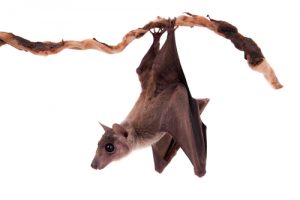Bats Nesting in Attics
By Chris Williams on May 20, 2011.
Q. We were sitting on our deck last night enjoying the warm evening when we saw what looked like a couple of bats swooping over the deck near our yard lights. Then we saw one crawl up under our roof overhang and disappear! Do you think we could have bats nesting in our attic!?
A. Could be. You’d need an inspection of your attic to tell for sure. But, you’re not alone; early summer is the peak time for bat complaints. It’s also the worst time of year to get rid of bats because there are young in the nests. Bats are protected animals so bat removal and bat-proofing of homes is usually scheduled for late summer and fall when the young have left the roost. If, however, bats are getting into the living areas of a home, that is a situation requiring immediate action.
Control of bats roosting in attics or voids in buildings means exclusion: getting them to leave and not allowing them back in. There are special one-way bat valves and netting systems that can do just that. Live-trapping them is also an option. Unfortunately, keeping the mother bat from her young in summer would mean the young would soon die. Bats are mammals so the young are breast-fed and cared for in the roost until they are old enough to fly, at 3 to 7 weeks.
So how are the bats getting into your attic? You may have discovered one opening. Typical entry points for bats are crevices where siding or roofing meets window frames, sills, gables, eaves, fascia boards, openings under roof overhangs where wood has shrunk or decayed, and loose louvered vents or loose flashing. You may see greasy rubmarks on the brick or siding underneath openings where bats are entering. Try a dusk inspection outside with binoculars. You should be able to see the bats coming and going from the roost site and may find that there is more than one entry/exit hole.
 Do not attempt bat control yourself and never handle a bat, live or dead. Call a pro instead. While rabies is a rare disease, bats can carry it. You don’t have to be bitten to get rabies from an infected bat. A scratch from an infected bat or simple contact with its saliva can spread the disease in certain circumstances.
Do not attempt bat control yourself and never handle a bat, live or dead. Call a pro instead. While rabies is a rare disease, bats can carry it. You don’t have to be bitten to get rabies from an infected bat. A scratch from an infected bat or simple contact with its saliva can spread the disease in certain circumstances.
After the bats are professionally removed from the roost, regardless of the method used, all entrances and potential entrances must be thoroughly screened, sealed, and closed off to prevent the bats from using them again. Bats can squeeze through openings less than 1/2 inch wide to get into attics, between ceilings and roof, and into wall voids. Do not attempt to seal openings before the bats are removed or before fall because you may seal young or adult bats into the attic space where they will starve to death and cause an odor problem. If there are a number of bats, you may also have to take special steps to have the bat feces (guano) removed from the roost site.
Bats are beneficial animals (they eat a lot of mosquitoes and other insects) and usually cannot be killed unless they have bitten or scratched someone and must be tested for rabies. Most states have specific laws protecting bats. At Colonial, we are experienced in dealing with bats. We practice humane bat removal and are experts in bat-proofing your home to keep bats out. Give us a call.
For more information on two common bats in our area, the little brown bat and the big brown bat, look under Nuisance Wildlife in our Pest Library.